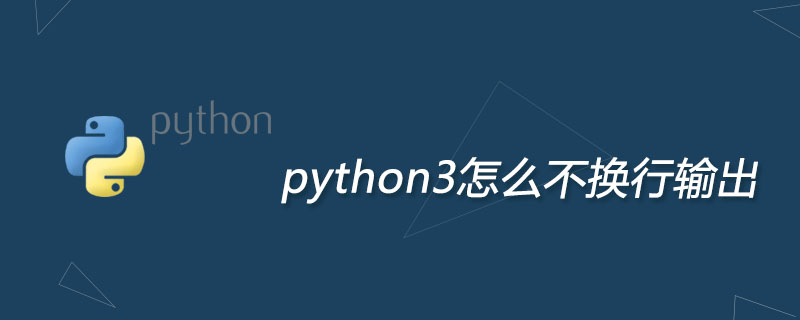
Python3 method of output without line breaks: Provide an additional named parameter [end=""] as the end parameter to the print() function to clearly mention that the string added at the end of the line should be used as the termination string. .

Since python's print() function ends with a newline character by default, it will automatically wrap by default. In Python there is a predefined format and if you use print(variable) then it will automatically go to the next line. So how can I output it without line breaks? The following article will introduce it to you, I hope it will be helpful to you.
How to output without line breaks in Python 3?
In Python 3, the simplest solution is provided, all you have to do is provide an extra parameter end to the print function. Example:
# 使用命名参数“end”指定行尾显式的字符串
print("Hello World!", end ="") #end里没有空格
print("My name is Karim")
# 数组
a = [1, 2, 3, 4]
# 输出数组的元素
for i in range(4):
print(a[i], end =" ") #end里添加空格Run:

We can use the optional named parameter end to explicitly mention the string that should be added at the end of the line.
Whatever you provide as the end argument will be the terminating string.
So if you provide an empty string, there will be no newlines and no spaces will be appended to the input.
Python print() function
The print() method is used to print output, the most common function.
Syntax:
print(*objects, sep=' ', end='\n', file=sys.stdout, flush=False)
Parameters:
objects -- plural, indicating that multiple objects can be output at one time. When outputting multiple objects, they need to be separated by ,.
sep -- Used to separate multiple objects. The default value is a space.
end -- used to set the ending. The default value is the newline character \n, we can change it to other strings.
file -- The file object to be written.
flush -- Whether the output is cached is usually determined by the file, but if the flush keyword argument is True, the stream will be forced to be flushed.
Return value
None.
The above is the detailed content of Why does python3 output without line breaks?. For more information, please follow other related articles on the PHP Chinese website!
 What is the use of java
What is the use of java
 Domestic Bitcoin buying and selling platform
Domestic Bitcoin buying and selling platform
 psrpc.dll not found solution
psrpc.dll not found solution
 Three mainstream frameworks for web front-end
Three mainstream frameworks for web front-end
 The difference between indexof and includes
The difference between indexof and includes
 How to calculate the factorial of a number in python
How to calculate the factorial of a number in python
 Computer system vulnerability repair methods
Computer system vulnerability repair methods
 How to solve the problem of access denied when booting up Windows 10
How to solve the problem of access denied when booting up Windows 10
 Latest ranking of digital currency exchanges
Latest ranking of digital currency exchanges